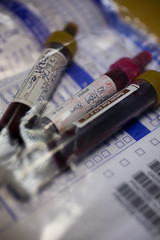Yksi jatkuvasti jopa skismaa aiheuttavista aiheista greyhound-treenareilla suhteessa ulkomaailmaan on rasituksen merkitys elimistölle. Vinttiliiton poppoo on vakuuttunut siitä, että kyseessä on vain ja ainoastaan merkki greyhoundjalostuksen päätymisestä umpikujaan (koirat eivät kestä) ja lääkärit ovat milloin diagnosoimassa verisyöpää, milloin akuuttia, kuolemaan johtavaa kuivumista. Pörröturkkien omistajille treenarit yleensä toteavat, että laittakaa koiranne edes kerran juoksemaan täysillä, ja eläinlääkärien olisi syytä hankkia ammattitaitoa ennen kuin yrittävät pelästyttää ns. paskat pihalle greyhoundien omistajilta. Katiskasta löytyy oman lauman perusveriarvoja talven peruskuntokaudelta ja netin syövereistä taasen kisarasituksen jälkeisiä arvoja. Laitetaan yksi sellainen tutkimusyhteenveto näkyviin – saadaan mitta-arvoja mitä rasitus oikeasti elimistölle tekee, jolloin voidaan jopa joskus – muissa piireissä – pohtia kahden ja kolmen startin päivävauhdin mielekkyyttä.
Hematologic, biochemical, blood-gas, and acid-base values in greyhounds before and after exercise.
Ilkiw JE, Davis PE, Church DB.
1989 Apr;50(4):583-6.
Department of Surgery, School of Veterinary Medicine, University of California 95616.
After racing 722 m, 16 Greyhounds were evaluated to determine changes in hematologic, biochemical, blood-gas, and acid-base values following exercise. Values were determined before racing (T0), immediately after racing (T1), and 3 hours after racing (T2). Significant changes detected immediately after racing included increased heart rate, respiratory rate, and rectal temperature. Significant changes in hematologic values included increases in PCV, total plasma protein, hemoglobin, RBC, WBC, neutrophils, and lymphocytes. Change was not detected in values for monocytes, eosinophils, and neutrophil/lymphocyte ratio. Other increases included those for plasma concentrations of sodium, chloride, calcium, lactic acid, aspartate transaminase, alanine transaminase, alkaline phosphatase, creatine kinase, lactate dehydrogenase, and glucose. Concentrations of potassium and urea did not change. Measurement of blood-gas and acid-base status revealed significant increases in PaO2 and base deficit, whereas PaCO2, pH, and bicarbonate decreased. Three hours after exercise, all vital signs and blood-gas and acid-base values, except for PaCO2, which was still slightly low, had returned to baseline (T0) values. Most biochemical values had also returned to baseline, although sodium, chloride, aspartate transaminase, and creatine kinase were still high, and urea was low. Many hematologic values were still different from baseline values, with high values for WBC, neutrophils and neutrophil/lymphocyte ratio, and low values for PCV, total plasma protein, hemoglobin, RBC, and lymphocytes.
PMID: 2712427 [PubMed – indexed for MEDLINE]
Changes in haematology and plasma biochemistry during maximal exercise in greyhounds.
Snow DH, Harris RC, Stuttard E.
1988 Nov 5;123(19):487-9.
Animal Health Trust, Newmarket, Suffolk.
The haematological and biochemical changes associated with racing over 235 and 420 metres were studied in 23 greyhounds. Blood samples were collected while the dogs were resting and immediately after and 30 minutes after racing. Significant increases in red blood cell count, haemoglobin concentration and haematocrit occurred. The increase in haematocrit was accompanied by increases in total plasma protein and creatinine concentrations. Blood lactate increased to 11.4 and 13.2 mmol/litre over 235 and 420 metres, respectively, and plasma glucose increased to 7.9 and 8.2 mmol/litre. After the 420 metres, the mean plasma ammonia concentration was 256 mumol/litre. Plasma free fatty acid concentrations also increased after dogs had run both distances. The highest concentrations of glycerol and uric acid were found 30 minutes after exercise.
PMID: 3201694 [PubMed – indexed for MEDLINE]
Effects of racing on hematologic and serum biochemical values in greyhounds.
Lassen ED, Craig AM, Blythe LL.
1986 Jun 1;188(11):1299-303.
Blood samples were collected on nonracing days from 57 racing Greyhounds at 2 weeks, 8 weeks, 13 weeks, and 16 weeks after the beginning of the racing season. Hematologic and biochemical tests were performed to detect marked changes induced by stress of racing. In general, these Greyhounds were healthy. Rhabdomyolysis was detected in one dog. In several other dogs, possible subclinical muscle injury was identified by increased serum creatine kinase activities. Mean serum Ca concentrations tended to decrease during the racing season. None of the tests was a good predictor of racing performance. Mean values for several hematologic and biochemical tests were different from those of other breeds of dogs.
PMID: 3721985 [PubMed – indexed for MEDLINE]
Santoro SK, Garrett LD, Wilkerson M.
J Vet Intern Med. 2007 Jan-Feb;21(1):107-12.
Departments of Clinical Sciences and Diagnostic Medicine and Pathobiology, College of Veterinary Medicine, Kansas State University, Manhattan, USA.
BACKGROUND: Greyhounds have lower platelet concentrations (PC) than dogs of other breeds have. No underlying cause has been investigated. HYPOTHESIS: We hypothesized that Greyhounds have lower mean PC because of breed variation, not immune-mediated causes. Our secondary hypothesis was that PC is dependent on the method of analysis. ANIMALS: Sixty privately owned Greyhounds in Kansas. METHODS: Blood samples were collected into evacuated glass tubes containing ethylenediamine tetraacetic acid (EDTA). Blood smears were evaluated for platelet clumps. All 60 samples had PC determined by manual, impedance, and buffy coat analyzer methods. Results of the 60 samples were compared with results of samples with (n = 25) and without (n = 35) clumps, and with control dogs. Platelets were assayed for the presence of surface-associated antigen (PSAIgG) by direct immunofluorescence. RESULTS: The mean PC was below that of the control dogs for the impedance method (P < .001). No significant difference in PC was detected between analysis methods or between samples with or without platelet clumps. Three of 60 (5%) of the Greyhounds had PC between 50,000 and 100,000/microL with impedance analysis; no samples had < 100,000/microL via buffy coat analysis. PSAIgG was not identified in any samples. CONCLUSIONS AND CLINICAL IMPORTANCE: The mean Greyhound PC for the impedance method was below the reference interval for control dogs but was not significantly different from PC determined by other methods. An immune-mediated cause for the lower PC was unlikely because no samples had PSAIgG. The decreased PC is most consistent with breed variation. As only 0-5% of samples, depending on analysis method, had PC < 100,000/microL, a Greyhound with a PC < 100,000/microL is not necessarily consistent with breed variation, thus diagnostic testing is indicated.
PMID: 17338157 [PubMed – indexed for MEDLINE]
Shiel RE, Brennan SF, O’Rourke LG, McCullough M, Mooney CT.
Vet Clin Pathol. 2007 Sep;36(3):274-7
Small Animal Clinical Studies Unit, School of Agriculture, Food Science and Veterinary Medicine, University College Dublin, Belfield, Dublin 4, Ireland. robert.shiel@ucd.ie
BACKGROUND: Greyhound dogs have numerous clinicopathologic differences compared with other dog breeds, most notably in their hematologic profiles. The hematologic differences are likely related to breed; however, the influence of other factors, including age, sex, and training, has not been fully determined. OBJECTIVES: The aim of this study was to assess hematologic values in young, healthy, pretraining Greyhounds and to determine the effects of age and sex on these findings. METHODS: Jugular venous EDTA-anticoagulated blood samples were collected from 43 healthy, pretraining Greyhounds between 5 and 13 months of age. Samples were analyzed within 24 hours of collection on an Abbott CELL-DYN 3500R hematology analyzer. Mean hematologic results for different age groups, and correlation with age and sex were determined for each analyte. Results were compared with adult canine, nonbreed-specific reference intervals. RESULTS: From the age of 9 to 10 months, Greyhounds had higher HCT, hemoglobin concentration, and RBC counts compared with adult canine reference intervals. Younger Greyhounds (5-6 months) had values comparable with reference intervals. Mean total WBC, neutrophil, lymphocyte, and platelet counts tended to be toward the lower end or below the reference intervals. HCT, hemoglobin concentration, and RBC counts were correlated positively with age, and platelet count was correlated negatively with age. No differences were found based on sex. CONCLUSIONS: These results confirm that significant hematologic differences exist in pretraining Greyhounds by 9 to 10 months of age, when compared with adult canine, nonbreed-specific reference intervals; however, these differences are less marked in Greyhounds 5 to 6 months old. Given these findings, it is unlikely that factors such as training or racing are responsible for differences in hematologic values between adult Greyhounds and other breeds.
PMID: 17806076 [PubMed – indexed for MEDLINE]
Serum creatinine concentrations in retired racing Greyhounds.
Feeman WE 3rd, Couto CG, Gray TL.
2003;32(1):40-2.
Department of Veterinary Clinical Sciences and Veterinary Teaching Hospital, College of Veterinary Medicine, The Ohio State University, Columbus, OH 43210, USA.
BACKGROUND: Greyhounds frequently have laboratory values that are outside reference intervals established for dogs. Our recognition of increased serum creatinine concentrations in several Greyhounds posed a problem when evaluating a Greyhound with suspected renal disease. OBJECTIVE: The purpose of this study was to compare serum creatinine concentrations between Greyhound and non-Greyhound dogs. METHODS: Thirty retired racing Greyhounds and 30 age- and gender-matched control non-Greyhound dogs were evaluated. Serum creatinine concentrations in both groups were measured using a standard biochemical method and compared statistically using a Kruskal-Wallis test. RESULTS: Creatinine concentration was significantly higher in the Greyhounds (P <.01) than in the control group. CONCLUSION: Greyhounds have a higher serum creatinine concentration than do non-Greyhound dogs. This idiosyncrasy should be taken into account when evaluating healthy Greyhounds and those with suspected renal disease.
PMID: 12655489 [PubMed – indexed for MEDLINE]
Kuva: ![]() photo credit: patrick h. lauke
photo credit: patrick h. lauke




